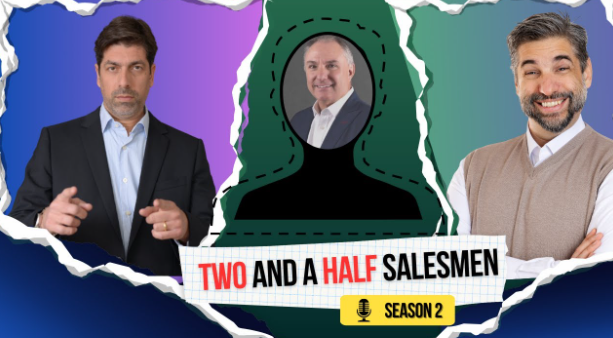In the latest episode of Two and a Half Salesmen, we sat down with Paul Wharf, RFC®, CCO of Intelliflo, to discuss one of the most gut-wrenching lessons a salesperson can experience: losing a $2.5 billion deal. However, rather than let the loss define him, Paul used it as a catalyst to rethink everything he knew about sales.
This isn’t your typical ‘always be closing’ nonsense. Instead, Paul breaks down the reality of modern sales, revealing hard-hitting truths about what works, what doesn’t, and why some deals slip through even the best hands. His advice is not just theoretical but practical and actionable, empowering you to make real changes in your sales approach.
The Hard Truth About Sales: It’s Not About You
Traditional sales processes are built around marketing strategies designed to push a product. However, as Paul explains, that approach completely ignores how customers buy. Too many salespeople focus on “training” customers to fit their process rather than aligning their approach with buying behavior.
Instead of leading with scripts and slides, sales professionals should take a step back and recognize when to shut up and let the customer lead. Paul highlights how Dr. Marvin Sadowski, a linguistic psychologist, helped major firms understand how customers communicate and make decisions. His research proves that adapting to a buyer’s preferred style of engagement significantly increases the chances of closing a deal.
Paul Wharf and The Myth of the “Perfect Sales Playbook”
Every sales team dreams of the magic bullet that will close more deals. But Paul shatters that illusion: there is no single formula for success. Too many companies invest in rigid cadences, automation, and cookie-cutter scripts for a shortcut. The reality? Sales isn’t about shortcuts; it’s about adaptability. Paul’s journey is a testament to the power of adaptability in sales, motivating you to embrace change in your own approach.
This was painfully clear when Paul lost the $2.5 billion deal. He and his team stuck too closely to their process instead of recognizing the client’s needs and adapting accordingly. The consequences were severe, with the deal slipping through their fingers. The takeaway? Customers don’t care about your playbook—they care about their decision-making process.
Understanding Buying Behavior: The Key to Smarter Sales
Paul emphasizes that truly great salespeople aren’t just talkers but listeners. One of the most effective techniques he learned was asking, “If you did know, what would you say?” This phrasing removes pressure from the customer, making them more comfortable sharing their real thoughts and priorities.
Additionally, Paul discusses how people absorb information differently. Some are visual learners, some are auditory, and others are kinesthetic. Recognizing this early on can dramatically improve communication and rapport-building.
Why Salespeople Resist Change—and Why They Need to Adapt
Even experienced salespeople struggle to adapt. Many have spent decades refining their pitch but fail to recognize when their approach stops working. Paul points out that most sales reps avoid deep discovery; instead, they rush to present their solution before fully understanding the customer’s needs.
This resistance to change is often what kills deals before they even begin.
Paul’s solution? Throw out the old sales playbook and start listening. Structured meetings, deeper discovery, and asking the right questions can transform sales conversations from generic pitches into meaningful, productive discussions.
The Importance of Continuous Learning in Sales
One of Paul’s biggest takeaways is that the best salespeople never stop learning. He shares how even top-tier athletes like Michael Jordan and Tiger Woods continue to practice their craft daily. If elite performers do the work, why should salespeople be any different? Continuous learning not only keeps you at the top of your game but also opens up new opportunities and strategies for success.
Yet, Paul notes that a shockingly low number of salespeople read books on sales or personal development. Many stumble into the profession rather than intentionally choosing it, and this lack of investment in learning often holds them back from reaching their full potential.
The $2.5 Billion Lesson: Lead While Listening
So, what was the biggest lesson from that massive lost deal? Paul realized that leading a sales conversation while truly listening is a delicate balance. Too many salespeople try to force customers into their framework instead of meeting them where they are. Everything changed when Paul shifted his mindset to prioritize customer buying behavior over his sales playbook.
The result? More meaningful conversations, stronger relationships, and better sales outcomes.
Want to Hear the Full Story?
Paul discusses his sales philosophy in even more detail on the podcast, sharing the highs, the lows, and the game-changing insights that transformed it.
Check out the full episode here and learn what it really takes to align your sales process with customers’ buying habits. This episode is a must-listen for any sales professional or business leader looking to improve their sales strategies.


